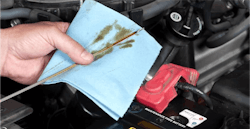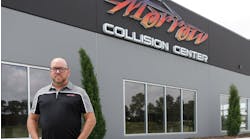There are numerous articles that focus on new technologies or diagnostic processes. But the bread and butter of our business still lies in the fundamental services and repairs we perform—and have been performing for decades.
Even though we’ve been performing these services forever, that doesn’t mean we should continue to do them in the same old way. I've had the chance to work with experts in numerous fields, and it was clear to me just how much even the most routine of services has changed to keep up with vehicle technologies.
I hope that you'll take some of the information I offer here and apply it in your own shop so that you can know in your heart that you are doing the best possible work for your customer.
Let's start with the most routine service of all, the oil change.
What are the top two causes of premature engine wear and engine component failure?
The first is lack of maintenance, specifically going too long between oil changes. It is important to explain to your customer the importance of changing the oil at regular intervals and help them decide, based on how they use their vehicle and the automobile manufacturer's recommendations, what interval is right for them. More on that in a bit.
The second most common cause of premature engine wear is the use of the incorrect oil and/or a poor quality filter for the vehicle application. And that is something you certainly have a little more say in. After all, aren't you doing the oil change?
Engine oil has always served several important purposes. It cleans the engine as it circulates, picking up contaminants and passing them into the oil filter where they can be collected and disposed of. Engine oil also contains additives that neutralize acids, prevent corrosion and protect against oil breakdown.
One of its most important jobs is to provide a thin cushioning film that prevents friction between the metal engine parts as they move against each other. The film also acts as a seal between the cylinder wall and piston rings. The overall reduction in friction reduces heat, cooling the metal components.
But if the oil is contaminated, the wrong type or past its prime, it won’t be able to flow effectively—and that can lead to expensive engine damage.
The engines you’re servicing today are so much more highly engineered and sophisticated from the ones many of us grew up on. And the manufacturers have very specific requirements for the oil you should use in them. The days of a "one size fits all' approach to selecting the oil you'll install in your customers' cars has long been a thing of the past. Always check the owner’s manual or your service information and use ONLY the oil that meets the requirements and specifications of the vehicle manufacturer.
How often should your customer come in for an oil change?
I guess the first question we need to ask is "Why change the oil at all?" Don't laugh—there are OEMs working on a "lifetime" fill just as they did on many transmissions. And the truth is that the base oil in any quality mineral or synthetic oil degrades very slowly in normal use.
The reason we can't leave the oil in there forever is twofold.
First, the additive package that helps the oil resist those factors that would cause it to break down becomes depleted. The depletion of the additives can lead to oxidation of the oil and an increasingly acidic fluid that will begin to corrode critical components.
Second, we need to periodically dump out the contaminants that have collected there. If left too long, the filter may become saturated. Now that nice clean filtered oil is oil that is contaminated with all sorts of debris, becoming a honing fluid that is going to rapidly increase the wear on all the engine's internal parts.
Back in the days of carbureted engines and low-quality mineral oils, the three months/3,000-mile service interval made sense. Today, though, some manufacturers are listing intervals as high as 15,000 miles or more.
One reason for this increased interval is the design improvements made to the automobile engine in the last 30 years. Engines today are more efficient and more tightly sealed, with less combustion blowby than the big gas guzzlers of the late 70s. Modern computer-controlled engine management means less fuel washing down cylinder walls and less liquid contamination of the lubricating oil. Another, and equally important, reason is the improvements made in oil chemistry as well as the advances made in filtration. Without these, the extended service intervals would not be possible.
I can’t stress the need for using the correct oil for the vehicle application enough. It is critical to engine longevity because of the increasing number of models equipped with small turbocharged powerplants and the variety of variable valve and cam timing systems, all relying on hydraulically activated components. So just make sure that you're using an oil that meets not only the OEM viscosity spec, but the API and/or ILSAC rating as well. Consider, too, that these ratings are a minimum standard. Just like your high school graduating class, there will be those in the group that excelled and those that just squeaked by.
Filter quality plays an important role
Control of solid contaminants is critical in protecting the engine from accelerated wear. The size of contaminate a filter is capable of stopping is measured in microns. How small a particle can a good oil filter trap? The standard used for testing is 20 microns and quality filters can all trap debris down to approximately 15 microns in size.
How big is 20 microns? Well, to give you an idea, 40 microns is about the size of the dust particles in fine flour. It's also about the smallest size the human eye can see. But trapping particles that size is not enough to truly protect that engine. In an older GM study, the engineers found that by filtering out particles larger than 30 microns resulted in a 50 percent reduction in engine wear. Bringing that filtration level down to 15 microns reduced wear by 70 percent!
Another measurement filters are subjected to in their testing is capacity—or how much dirt and debris can they hold before they can hold no more. The type of filter media used as well as the number of pleats the filter has goes a long way in determining that capacity. What happens when the capacity is exceeded? If the capacity of the filter media is exceeded—whether due to exceeding the recommended service interval or selecting a low-quality filter—that nice clean filtered oil is being mixed with oil that is contaminated with all sorts of debris. The contaminated oil then becomes, literally, a honing fluid that is going to rapidly increase the wear on all the engine's internal parts.
Using a high-quality oil and a cheap filter isn't doing the engine, or your customer, any favors. Switching them over to an extended life oil or switching from a synthetic from a conventional oil, all in the name of extending their service interval, while using the same filter you always used, is a recipe for disaster.
A few other important factors to consider
When recommending the best oil change interval for your customer, stick to the OEM guidelines. And even then, you may have to customize it a bit for your customer.
For example, some OEMs still list two different maintenance schedules based on use: normal or severe. Discuss this honestly with your customer. If they use the vehicle as a grocery getter and it rarely runs more than five miles at a time, you'll need to recommend a higher service interval for them. The same is true for your customer towing heavy loads much of the time or if you're living in an area where most of the roads are dirt rather than paved.
Another critical point that is often overlooked is considering the normal oil consumption of the engine. Some manufacturers consider a quart of oil lost every 2,000 miles or so perfectly acceptable. But if your customer is changing their oil every 15,000 miles, they could find themselves running dangerously low on oil before the next service comes around.
Take the time to explain that to them and show them how to check the oil, and other fluids, under the hood and recommend they do so every time they put gas in the tank.
And if your customer's vehicle is equipped with an Oil Life Monitoring system, be sure to tell them they should have the oil changed at least annually, regardless of mileage or what the monitor says. Just be sure to reset the OLM when you do perform the service.
Oil isn’t the only fluid
Performing an oil change is also the time we routinely inspect the underhood fluids. Here, I want to focus on the second most important fluid affecting the engine’s health: the coolant.
Coolant service intervals have grown, with many OEMs not recommending service until the vehicle has reached 100,000 miles or more. Yet, Class 8 trucks will go over 500,000 miles on a single coolant fill. What's the difference? It's all about the additives.
Coolant performs its job in a harsh environment, subject to all kinds of factors that can lead to the early demise of the protective additives the coolant contains. Once these additives are depleted, the degradation of the coolant will accelerate, leading to acidic byproducts that will eat away at the cooling system components and passageways. Even in a perfect world, an engine’s coolant will degrade over time and require replacement at intervals recommended by the OEM.
But we don’t live in a perfect world, and there are many factors that can cause the coolant to require service much sooner. That's why checking the condition of the coolant should be a part of any routine maintenance.
Even if you personally serviced the cooling system just six months ago, you can’t control all the factors that impact the coolant’s longevity. Did someone add water to the system, diluting the mix? Is there a combustion leak in the cooling system, attacking the additive package? Is there a faulty ground that is allowing stray current to flow through the coolant?
There’s only one way to know for sure. Inspect the coolant condition by inspecting three things. There are a number of sources for test strips designed specifically for this purpose, allowing you to measure three key indicators at once. Others may require the use of a refractometer to accurately measure the current coolant dilution rate.
First is the dilution ratio of the coolant mix. Ideally, it should fall between 40 percent and 60 percent. Too much coolant will interfere with the ability of the mixture to transfer heat and too little will impact freeze and boil points.
Next is Reserve Alkalinity. Metals in the engine’s cooling system are prone to acid-catalyzed corrosion. If coolants become acidic, such as from exhaust gas leakage or coolant oxidation, system components may be at risk for damage. Buffers are added to maintain pH at the proper level. Reserve Alkalinity is a measure of how much acid a coolant can absorb before it reaches a pH of 5.5. Look for an RA of 6.6 or more. If it’s low, the coolant may still be serviceable, depending on the current acidity level of the mixture.
Last is the pH measurement. pH is an indication of the health of the buffers included in the inhibitor package added by the coolant manufacturer. When these buffers become depleted, system and component corrosion will soon follow.
Dilution issues can be corrected by adding water or concentrated coolant as needed to restore the mixture ratio. Issues with pH, however, requires a complete cooling system service to correct. And if the coolant has degraded well before its normal service interval, be sure to inspect—and correct—the causes prior to replacing the coolant.
And No. 1 is?
I'm hoping that you all understand that choosing the correct coolant is just as important as using the correct oil for the vehicle application. But how many of you give the same thought to the water you use?
Water straight from the tap is perfect for staying hydrated in the dog days of summer. But it’s not the best choice for use in an engine’s cooling system. Tap water contains minerals and chemicals that could lead to rust and corrosion in the cooling system. They can also cause the coolant’s inhibitor package—that is, the additives used to lubricate and protect the cooling system—to be depleted prematurely.
So, if not tap water, then what do you use?
Look closely at the back of coolant concentrate containers and you’ll see that many coolant manufacturers specify the use of deionized water when making your 50/50 mix. It’s also a good idea to use the same water when performing any kind of flush on the system.
Deionized water is a deeply demineralized and purified water with a resistivity of close to 18 megohms. That means it highly resistant to electrical current flow—an important consideration when you think about all the electrical components that ground themselves through the engine block. This water is about as pure as you can get and is your best choice for use in the coolant mix. However, if you can’t find or obtain DI water, you can use distilled water in its place.
Another solution is to ask your supplier for a pre-mixed version of the coolant you need. This is becoming a popular option and makes it easy to ensure that your 50/50 mix is the right 50/50 mix for your customer!
Other causes to consider
Another common cause of premature loss of the additives is the presence of undiagnosed combustion leaks, allowing spent exhaust gases to mix with the coolant. These leaks may be present even if your customer has no related drivability concerns or symptoms.
Another common cause of premature degradation is stray voltage from improperly grounded electrical circuits. You may be able to check for stray voltage by testing with your Digital Voltmeter. With the key off, ground the negative lead of your meter at the battery. Insert the positive lead into the coolant in the radiator. Avoid touching anything metal—keep the tip in the coolant.
You’ve already determined that the coolant has become too acidic, so any reading you see at this point is likely caused by that. It’s called a galvanic reaction and is the chemical reaction between the acidic coolant and the metals in the cooling system components. It’s the same kind of reaction the battery uses to produce voltage.
Next, turn on the key and start the engine with every accessory turned on. If the voltage reading increases and exceeds 0.30 volts, test the vehicle’s electrical grounds and repair as needed. Finally, be sure to retest after the coolant service to verify you’ve corrected the problem.
What about the brake fluid?
What, exactly, are you checking for when it comes to inspecting the brake fluid?
Brake fluid performs several important jobs. First, it’s the medium that transfers pedal force to the brake pads and shoes. Second, it lubricates the system’s seals and components. And third, it protects the metal components, from ABS valves to brake lines, from internal corrosion.
Checking your customer’s brake fluid begins with the obvious—a look at the fluid level in the master cylinder reservoir. Take a look at the level indicators on the side of the reservoir. Is the fluid near or below the minimum mark? Brake systems are “closed” systems, and brake fluid doesn’t evaporate. If the fluid is low, there is either a leak in the system or the level has dropped because of pad wear.
Most vehicles actually have some type of fluid level sensor for this very reason—to warn the driver that their brake system needs professional attention. And it is for this very reason you should never add fluid to the reservoir during your routine service. Doing so effectively bypasses this warning system and your customer could continue to drive the car until the only other warning is the grinding noise the brakes will make when the pads are finally worn completely out—or the sudden loss of brake pedal caused by an unrepaired leak!
So never top off brake fluid; perform a full brake system inspection instead.
The next step is to check the integrity of the fluid itself. And while moisture contamination used to be the major issue associated with brake fluid, today the focus is on the condition of the additives in the fluid.
Just like the coolant we just discussed, these additives include corrosion inhibitors that protect the brake system metals and antioxidants that reduce the decomposition of the fluid’s base and slow the formation of acidic decomposition byproducts. Testing the condition of the fluid and gauging the health of the additives is best done with a test strip. Some strips react to the amount of copper present in the fluid. This copper comes from the corrosion of the copper brazing in the system’s brake lines and is one indicator of the additives ability to protect the system.
But some research has found that once a system has been flushed and the fluid replaced, the amount of copper in the system is reduced, even eliminated. And that can impact further checks of the system that rely on copper measurement. An alternative is to measure the pH, or acidity, of the fluid. The strip reacts to the decomposition of the fluid and additives, much like testing the pH of coolant.
And while the need for routine brake fluid service is recommended by some manufacturers and ignored by others, if your testing shows the fluid additives have been depleted recommend a fluid flush to protect those expensive ABS valve bodies and other brake components.
The services we perform to help our customers maintain their vehicles hasn’t changed much over the decades— it’s the details of the how we perform them that’s changed. Treating these services the same way you’ve always done is a disservice to your customer and besides, it takes no more time to do it right.



